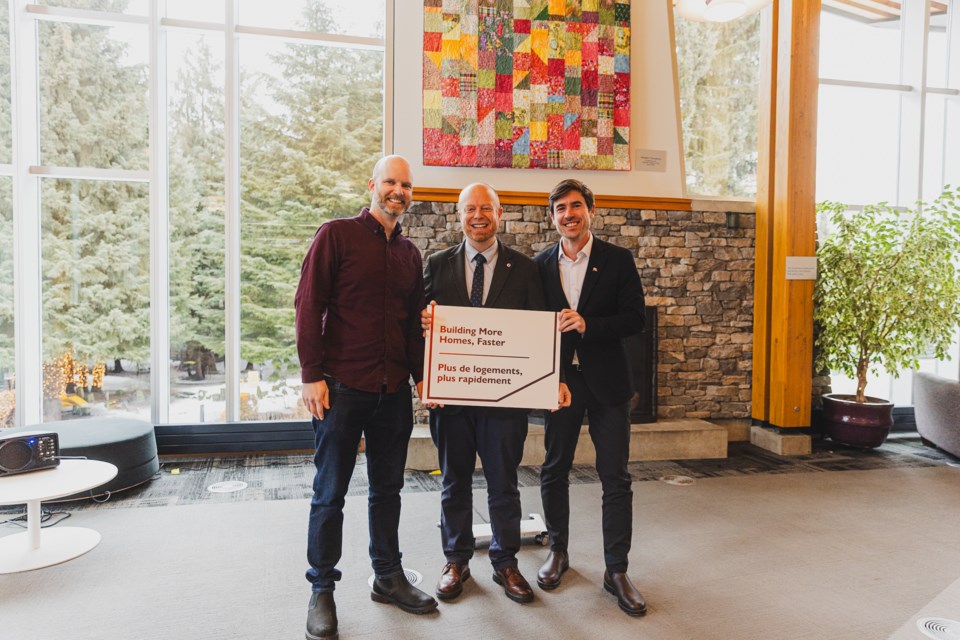Whistler will receive $2.5 million through the Government of Canada’s Housing Accelerator Fund (HAF), money that will help spur the construction of 62 homes over the next three years and 814 over the next decade.
Sea to Sky MP Patrick Weiler announced the news at the Whistler Public Library on Thursday, Feb. 20, calling it “a really important day” for the resort’s housing landscape.
“This is more than just about numbers. It's about making housing more accessible, faster and more efficient. It's about cutting unnecessary delays, rethinking zoning and making better use of the land that is already here or could be better utilized,” Weiler said.
Whistler is the latest Sea to Sky municipality to receive money from Ottawa’s $4.4-billion HAF, an initiative launched in 2023 requiring approved local governments to develop housing action plans.
Local governments are “encouraged to think big and be bold in their approaches, which could include accelerating project timelines, allowing increased housing density, and encouraging affordable housing units,” a federal release said.
The Resort Municipality of Whistler’s (RMOW) 2023 Housing Action Plan, one of the most significant and extensive housing strategies the municipality has produced, is broken into several core efforts, including a comprehensive review of building fees, charges, and infrastructure needs supporting strategies for future growth. The RMOW will also pre-zone specific areas for multi-family residential developments, with a mix of market and affordable non-market housing. Development review timelines—a persistent headache for local builders, who have criticized the RMOW for its often-opaque permit approval process and lengthy wait times—will be shortened by prioritizing workforce housing applications and digitizing its permitting process, something the local building community has been calling for for years.
“We have earmarked a portion of the funds—so on the municipal budget this year and in the future—designed to help us reconfigure what we call our back end [of the permit application process]. But this money will really help us accelerate that work and also start our work on the front-end side of that, which is that user interface,” explained Dale Mikkelsen, GM of the RMOW’s Climate Action, Planning and Development Services division. “We often find our system is old, outdated, cumbersome or challenging to deal with and that hurts the efficiency of the application. Because, as we know, if the application is not good and complete, it becomes harder to process.”
The funds will be spread across various municipal departments to tackle Whistler’s longest-standing challenge. In the engineering department, “it’s going to enable us to accelerate our look at the infrastructure needs” of future housing sites, Mikkelsen said. “So how much water do they need? How much sewer do they need? Do they have the electrical capacity to take on density? And how quickly can we do that?”
In the building department, funds will support the modernization and implementation of a new building bylaw intended to streamline the approval process and better clarify the respective roles of both the municipality and the permit applicant.
In the planning department, Mikkelsen said the funds will be used “in many ways,” including the development of a municipal land strategy identifying future housing sites for non-market units “over the next five, 10, 20 years that we can help accelerate,” he added.
In December, RMOW staff presented the results of a provincially mandated Interim Housing Needs Report, estimating that, based on current population trends, Whistler will require 1,572 new housing units in the next five years, and 5,639 in the next 20.
Although the RMOW has made significant headway on housing in recent years—Phase 2 of Cheakamus Crossing’s development is nearing competition, which, at build-out, will have added more than 500 non-market units to Whistler’s stock—the municipality has reiterated time and again that it can’t solve the resort’s housing crisis alone.
"We knew it was very important to ensure it was easier for builders to build. It can't just be local government that does it in this town, it needs to be private builders,” Mayor Jack Crompton said. “So, we're extremely excited and grateful that the federal government and the Canadian Mortgage and Housing Corporation has decided that this investment is important to them and to us. It's going to help us in that important work, and we're excited to put that money to work.”
The RMOW previously applied and failed to secure funding through the HAF, until Weiler encouraged resort officials to take another look at their application and resubmit.
“He worked incredibly hard for us as a community to ensure that it wasn't just Pemberton and Squamish that were successful, but Whistler was,” said Crompton.
The federal government has estimated the HAF will fast-track at least 112,000 new homes across Canada by 2028, and an estimated 750,000 new homes over the next decade. Whether the fund will still exist at that point is anyone’s guess. Federal Conservative leader Pierre Pollievre has vowed to end the HAF if elected prime minister, instead planning to remove GST from new home purchases.






